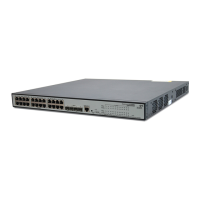
Do you have a question about the HP V1910 and is the answer not in the manual?
| Switching Capacity | 56 Gbps |
|---|---|
| Forwarding Rate | 41.7 Mpps |
| Manageable | Yes |
| Form Factor | Rack-mountable |
| Features | VLAN, QoS, Link Aggregation |
| Operating Temperature | 0°C to 45°C |
| Operating Humidity | 10% to 90% (non-condensing) |
| Ports | 24 x 10/100/1000 + 4 x SFP |
Guides on how to log in to the web interface using default credentials.
Provides default username and password for web interface login.
Details the process of obtaining and upgrading the system software image.
Guides on setting operation parameters for Layer 2 Ethernet ports.
Covers adding local user accounts, setting super passwords, and switching management levels.
Guides on creating new local user accounts with specific attributes.
Explains how to set a super password for non-management users to switch to management level.
Guides on configuring storm constrain settings and adding port storm constrain configurations.
Guides on enabling or disabling SNMP and configuring parameters like SNMP version.
Guides on creating and configuring SNMP communities with access rights and views.
Explains how to create SNMP groups, define security levels, and associate them with views.
Guides on creating SNMP users, assigning them to groups, and setting authentication/privacy modes.
Guides on enabling SNMP traps and configuring target hosts for traps.
Provides two approaches for configuring VLANs, including creating and modifying VLANs.
Guides on modifying IPv4 address, admin status, and IPv6 configuration for VLAN interfaces.
Details how to modify VLAN settings, including member types and port assignments.
Explains how to modify port membership types (untagged, tagged, not a member) within VLANs.
Guides on configuring voice VLAN globally and per port in automatic assignment mode.
Details configuring voice VLAN globally and per port in manual assignment mode.
Guides on creating static or dynamic MAC address entries.
Outlines tasks for configuring LLDP, including enabling it on ports and globally.
Details how to configure LLDP operating mode, encapsulation, and CDP compatibility on ports.
Outlines tasks for configuring IGMP snooping globally and in VLANs.
Details enabling IGMP snooping within a VLAN and configuring version and querier.
Guides on enabling or disabling IGMP snooping globally.
Lists tasks for configuring the DHCP relay agent, including enabling it and creating server groups.
Explains the ping command for verifying device reachability and examining network connectivity.
Describes trace route for tracing Layer 3 devices and identifying failed nodes in network failures.
Guides on performing ping operations using the web interface.
Explains how to perform trace route operations using the web interface.
Introduces ARP detection to forward only authorized client ARP packets and prevent man-in-the-middle attacks.
Guides on enabling 802.1X authentication globally and configuring authentication methods.
Details how to configure 802.1X authentication on individual ports, including port control and authorization.
Outlines configuration prerequisites and tasks for AAA, including ISP domains and authentication methods.
Covers RADIUS parameters like server type, shared keys, NAS-IP, timeouts, and username format.
Guides on configuring local users and user groups.
Guides on creating new local user accounts with specific attributes.
Outlines PKI certificate request modes (Manual, Auto) and configuration tasks.
Guides on manually requesting PKI certificates, including creating PKI entities, domains, and key pairs.
Details the process of creating a PKI entity with its identity information.
Explains how to create a PKI domain and set the certificate request mode.
Guides on generating a local RSA key pair, an important step for certificate requests.
Guides on configuring port isolation by modifying the role of ports in an isolation group.
Guides on associating ACLs with Telnet and HTTP services to filter client requests.
Outlines tasks for configuring an IPv4 ACL, including time ranges and creating ACLs.
Details creating an IPv4 ACL, specifying ACL number and match order.
Guides on creating rules for basic IPv4 ACLs, including operation, fragment checking, logging, and source IP.
Details configuring rules for advanced IPv4 ACLs, including IP address filters, protocols, and TCP/UDP ports.
Explains configuring rules for Ethernet frame header ACLs, including MAC address filters and Type Filter.
Outlines tasks for configuring QoS policies, including creating classes, behaviors, and policies.
Guides on defining QoS policies by associating traffic classes with traffic behaviors.
Details how to create a class by specifying a classifier name and operator.
Explains how to define match criteria for classifiers, including DSCP, IP precedence, MAC, and VLAN.
Guides on creating traffic behaviors by specifying actions like filtering, mirroring, and redirecting.
Guides on creating a QoS policy by naming it and associating classes with behaviors.
Explains how to associate classifiers with traffic behaviors within a QoS policy.
Guides on applying a QoS policy to a specific port in either inbound or outbound direction.
Outlines the process of configuring PoE and its ports.
Guides on enabling/disabling PoE on selected ports and setting power priority.